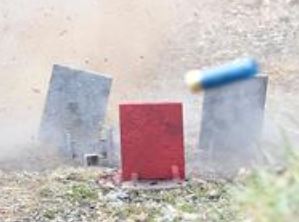Random Shots – latest news
Well the last shot has been fired at a UKPSA match, and the 2021 competition season is officially over (except of course for the excellent postal league). Despite Covid-19, UKPSA clubs and NROI members have stepped up magnificently and overcome all the challenges to successfully deliver 14 national and international matches. I’m immensely proud of you and how despite everything thrown at us we have kept our sport on the road.
Don’t forget that now is the time to get a copy of your match points record card into NROI@UKPSA.ORG so I can update your NROI record and send out the 2022 card. You have until 30th January to get your card in!
They say that adversity is the mother of invention. That was certainly the case in 2021 with NROI training, where we seized the opportunity presented by the break in our sport to completely re-design the level 1 seminar. Many hundreds of hours later we now have a largely online programme supported by a full day of hands on practical training and assessment. With the new programme in place, the training of members has continued at pace and we have seen a significant increase in the number of people becoming qualified match officials. I would really like to thank Dave Peacock for his assistance with this and especially his work in developing the online tests.
I am happy to report NROI membership has grown in 2021 and we are on track to meet our targets in the new UKPSA Strategy. I am also pleased to announce that four of our more experienced members have been accepted by IROA, increasing for the first time in several years the number of IROA members from Great Britain. Congratulations guys!
2022 is already shaping up to be a cracking competition year with matches at venues old and new. I know that some matches are already fully crewed, but there are still plenty of opportunities for NROI members. These include the first Mini Rifle championship match of the year at the expanded Carlisle Small Arms Club in March (contact Vanessa Duffy), the Home Countries at North Cotes in April (contact Pete Savage) and the Cotes of Iron match (contact Iain Corrigan). Also in planning is the new Scottish Masters at the end of August and if you are interested in working at what promises to be a great match at this exciting new venue please get in touch at martyn.spencerm17@gmail.com
 Next year I personally plan to focus on my own shooting, working at matches in Great Britain (and hopefully abroad) and supporting the work of IROA, so the role of UKPSA NROI Chair will fall to someone else.
Next year I personally plan to focus on my own shooting, working at matches in Great Britain (and hopefully abroad) and supporting the work of IROA, so the role of UKPSA NROI Chair will fall to someone else.
I would like to thank the NROI committee, and in particular Dave Peacock , the NROI Secretary, for their support over the last few years. The UKPSA is extremely fortunate in having an experienced NROI committee with members who make a significant contribution to the sport in Great Britain and globally. Through this, the Association and its members benefit from the influence the UKPSA has in shaping the global sport and in gaining early insight into any planned developments or changes. Their significant international experience as match officials at continental and world championships also benefits our delivery of UKPSA matches and training, and has led to our match officials and training having an exceptionally good reputation worldwide.
Finally I would really like to thank you, the UKPSA match officials who have worked hard to deliver our sport. You are the backbone of IPSC shooting, the people who with the Match Directors and clubs actually deliver our matches, and without you we would have no sport. I look forward to working with you all in 2022!
I would like to wish you and yours, a merry Christmas, and a happy new year.
Take care and stay safe.
Martyn Spence
Lessons from the line
Awarding procedural errors for faulting a line
Recently we’ve seen matches where the question of how many penalties to award arose with competitors faulting the line and in some cases leaving the shooting area altogether.
It is worth thinking about this from a number of perspectives. First of all construction. Some recent examples have been where multiple stages have been built using the same/close fault lines. Inadvertent faulting in this case is really unfortunate. So something to watch for in the build is making sure the various shooting areas are clearly and distinctly defined.
Where penalties are justified by competitor action, it is important that the RO remembers there are two options. The first is for inadvertent faulting and this normally results in one procedural error penalty only (see rule 10.2.1). Only where a significant advantage is gained (rule 10.2.2) do we apply multiple penalties. So an important consideration for the RO is always how many shots were fired and which of those shots benefited from a significant advantage as only these attract an additional penalty. If in doubt check with your CRO or Range Master.
Using No Shoot Metal Targets in Shotgun
Thanks to Neil Beverley for this excellent summary of what to consider when using and testing metal no shoots.
When you add a no-shoot in close proximity to a scoring target then Sections 5 and 7 of the IPSC rules apply AND NOT Section 6. In these cases then the Range Master or his/her designate may carry out a test with the calibration gun and calibration ammo, before the match starts.
Section 4 gives the Range Master authority to decide which targets to test so they aren’t obliged to test every target prior to the start of the match. So “must make arrangements” can amount to a visual inspection and a simple decision that all is OK. In reality we only check “suspect” targets and certainly not all.
The test is ALWAYS in the most advantageous and easiest location available on the stage to shoot the target. This is different from single projectile disciplines like Handgun. Even if it requires moving many metres to get a better angle or to be closer, then this is where the test shot is fired. The decision to shoot from somewhere more difficult rests with the competitor and competitors cannot ask for a test shot/calibration shot from where they fired at it. The test is always the easiest shot available, whether that is at an angle or physically closer. Of course this may mean that from one location, only a small part of a plate may be visible but from somewhere else the full target may be visible.
Competitors can also change to tighter chokes and use a bigger shot size, in both cases improving the tightness of the pattern. So, if the match official can successfully knock over the plate with an open-choked gun and No.7 birdshot, then it should be easier for a competitor with, for example half or full choke.
At 5 to 7 metres being able to see half a plate is usually enough. At 20 metres I would want to see a clear gap between the scoring target and the no-shoot. Use standard scoring metal targets but no-shoots are better if they don’t fall too easily. You want to avoid where possible no-shoots that fall if just hit by 1 or 2 birdshot pellets.
Be sure to only paint the front side of no-shoots and NEVER paint the back as well. This is so you can see if a shot hit the no-shoot and not a ricochet onto the back.
Developing your Institute
NROI members accepted into IROA
Congratulations to Ken Trail, Russ Hicks, Rob Brittain and James Nixon who have all been appointed IROA Range Officers. This brings our total IROA membership to thirteen, the highest for many years.
Latest Level 1 IROA/NROI seminar
For anyone interested in training to be a UKPSA match official we are now taking bookings from UKPSA members that have the relevant experience and can meet the entry criteria for the next seminar. Please do pass this on to members of your club with the relevant match experience.
The next taught seminar will commence on 12th February 2022 but students need to be registered by 2nd February to prepare for the course and complete the pre-learning.
If you know any members who would make a great RO please encourage them to register today!

